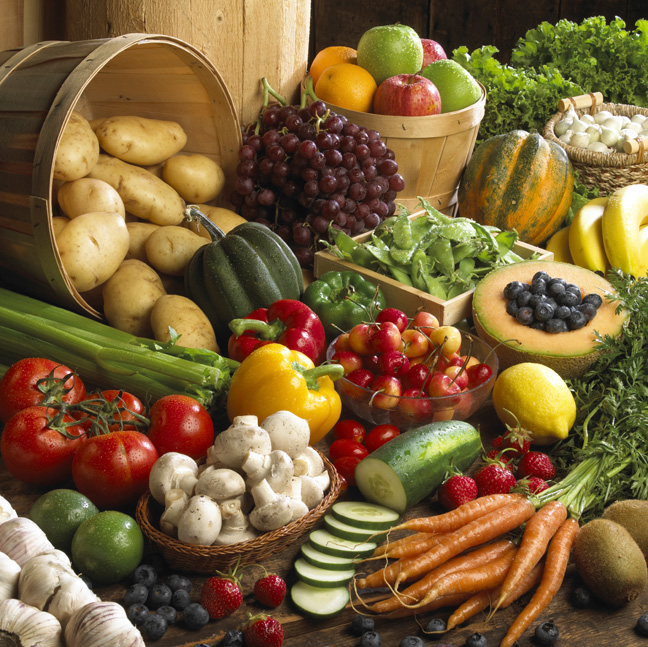Vitamin C (ascorbic acid)
 Vitamin C is also known as ascorbic acid and L-ascorbic acid. Most animals are able to synthesise vitamin C by means of a stepwise, enzymatic conversion of glucose (dextrose). However, humans, apes, guinea pigs, and certain other animals have lost this ability during evolution. The largest concentrations of vitamin C are found in the white cells of the immune defence, the pancreas, the testicles, and the ovaries. Vitamin C is water-soluble and as it is not stored in the body, we depend on regular intake of the nutrient. Vitamin C is destroyed by light, heat, boiling, freezing, preservation, and storage (including winter storage of vegetables and fruit).
Vitamin C is also known as ascorbic acid and L-ascorbic acid. Most animals are able to synthesise vitamin C by means of a stepwise, enzymatic conversion of glucose (dextrose). However, humans, apes, guinea pigs, and certain other animals have lost this ability during evolution. The largest concentrations of vitamin C are found in the white cells of the immune defence, the pancreas, the testicles, and the ovaries. Vitamin C is water-soluble and as it is not stored in the body, we depend on regular intake of the nutrient. Vitamin C is destroyed by light, heat, boiling, freezing, preservation, and storage (including winter storage of vegetables and fruit).
Functions and importance for
- Formation of collagen in connective tissue, which contributes to:
- The structure of blood vessels
- Healthy bones and cartilage
- Healthy gums and strong teeth
- The structure, complexion, elasticity, and moisture of skin
- Energy turnover and energy levels
- The uptake of adrenalin and noradrenalin in the adrenal glands. This plays a major role in connection with physical and psychological stress.
- Iron uptake
- The immune system - also during and after physical training
- The nervous system and mental balance
- Recycling of the active form of vitamin E
- As an antioxidant that counteracts the damage caused by free radicals and oxidative stress
- Takes part in intracellular redox systems (a type of electron regulation). However, the exact mechanism is not known
- Reduction of fatigue and exhaustion
Deficiencies and poor utilisation may be caused by
- Physical and psychological stress
- Smoking
- A large consumption of alcohol and narcotics
- Oxidative stress caused by free radicals
- Too little gastric juice
- Contraceptive pills and sleeping pills
- Sugar. The reason is that sugar and vitamin C compete for the same channels that lead into the cells. The more sugare you consume, the less active vitamin C becomes
Deficiency symptoms
The body's collagen and connective tissue get a loose structure that may lead to numerous symptoms, such as:
Bruising, bleeding gums, nosebleed, and poor would healing. This is a condition known as subclinical scurvy.
Scurvy, the classic deficiency disease and extreme consequence of vitamin C deficiency, leads to lethal internal hemorrhaging. This condition used to be widespread among sailors and people in the underdeveloped countries.
Also observed:
- Fatigue
- Iron deficiency
- Impaired immunity and frequent infections
- Cardiovascular diseases. According to Nobel Prize-winner Linus Pauling, long-term low blood levels of vitamin C may lead to atherosclerosis.
Sources
Mainly fruit and berries but also vegetables like cabbage, bell pepper, horseradish, spinach, garlic, and herbs.
Vitamin C content in mg per 100 grams
| Acerola - tropical fruit | 1.300-1.700 |
| Rosehip | 1.250 |
| Bell pepper | 191 |
| Brussels sprouts | 90-150 |
| Oranges | 50 |
Recommended daily allowance (RDA)
Adults: 11 years of age and older: 80 mg
Children: 1-10 years of age: 40 mg
Nonacid supplements
Salts of ascorbic acid are called ascorbates and are used in nonacid supplements with sodium ascorbate or calcium ascorbate. Nonacid supplements are gentler towards the mucous membranes in the gastro-intestinal tract.
Increased need
- The above mentioned deficiency symptoms and with the use of medical drugs
- Abuse of tobacco, alcohol, and narcotic substances
- Oxidative stress (e.g. lesions, burns, and infections)
- Physical and psychological stress
- Overconsumption of sugar
Contraindications of supplementation
- Caution should be taken in situations such as:
- Reduced kidney function and tendency towards kidney stone formation
- Diseases where iron tends to accumulate in the body
- Diarrhea
- Use of blood-thinning medication
- If in doubt, ask a physician
Overdosing - side effects
Symptoms of overdosing are rare, as excess amounts of vitamin C are excreted in the urine. Ingestion of greater quantities than two grams daily (especially as pure ascorbic acid) may cause diarrhea, nausea, irritated urine bladder, and increased risk of kidney stones. It appears to be more of a theoretical risk, however, as kidney stone cases as a result of taking ascorbic acid are not seen in practice.
Synthetic manufacturing and additives
It is very easy to manufacture ascorbic acid and ascorbates synthetically. These compounds are mainly used in vitamin C supplements. The food industry uses these substances as antioxidants and harmless preservatives to prevent oxidation. Their E numbers are 300, 301, 302, and 304







